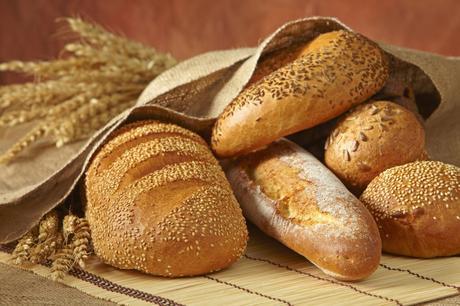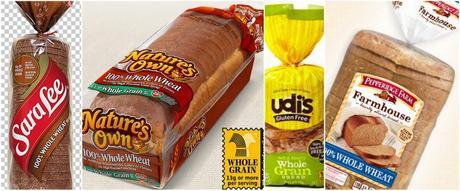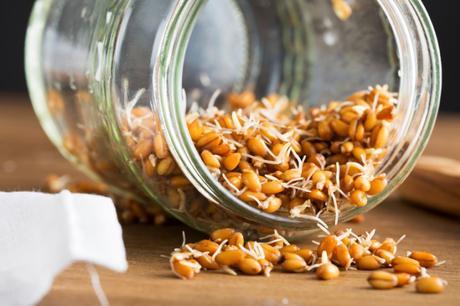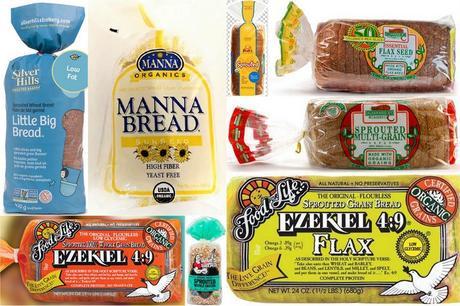
One of the questions I get asked most often is: do you eat bread?
And people are usually surprised when I say that bread is one of my favorite things to eat. Of course I eat bread! I love the smell of fresh bread in the morning, whole grains, and all of the ways you can use bread in recipes.
Bread has gotten a really bad reputation because of various diet fads: no-carb, gluten-free, paleo, etc. It's been vilified as the cause for everything from weight gain, to inflammation, to diabetes, to digestion issues... the list could go on. The truth is, bread as a general category is usually processed and high in sugar and simple carbohydrates - which can cause weight gain and other issues. Also, the main problem with wheat (unless you have celiac disease or a severe gluten sensitivity that has been diagnosed) is that we eat too much of it as a society in general.
Eating white bread, white crackers, white pasta, white rice (white anything, basically) is the equivalent to taking a spoonful of sugar and dissolving it in your mouth. This is because when you eat a grain that has been refined into flour, your body quickly metabolizes it like a sugar, which causes your insulin to spike. This can make you gain weight and contributes to diabetes and inflammation.
But there are types of bread that can actually be really good for you and cause all of these problems! So how are you supposed to figure out which bread is the healthiest? And how can you avoid those breads that look healthy but actually aren't?
That's where this post comes in!

This is your guide to the healthiest breads on the market.
I'm going to help you find your way through the many marketing labels like "whole grain," "multigrain," "12 grain," "wheat," or "all natural" on the 50+ bread varieties you'll see at your local grocery store, and give you the list of the healthiest bread to buy.
But first, here are some general ground rules for buying bread:
Ingredients to ALWAYS AVOID:
- Anything white
- Anything with "enriched," "bleached," or "unbleached" as part of the first ingredient. "Enriched wheat" = "White"
- Be wary of "wheat" or even "100% whole wheat" - some breads will have this as an ingredient but are still highly processed and refined
- Anything with less than 2g fiber per serving
- Anything with raisins, dried fruits, cinnamon, banana, honey, or vanilla listed on the packaging
- Dough conditioners (like azodicarbonamide, DATEM, monoglycerides, diglycerides, sodium stearoyl lactylate): these are just chemicals added to the bread to make the bread making process faster and scalable to big batches. They're not necessary for real bread, and if these ingredients are on the label, it's a good sign that the bread isn't truly healthy.
- GMO ingredients like soybean oil and corn oil (honestly, these are just not necessary to make bread)
- Preservatives (like calcium propionate): bread isn't supposed to be able to last on the counter for 1-2 weeks without getting hard and moldy. If you see any ingredients you can't pronounce, it's likely a preservative so put the bread down and find another option.
- Added sugar: If your bread has yeast, it will likely have a tiny bit of honey or sugar because you need sugar to activate yeast. That being said, anything over 2g per slice is unnecessary. Watch out for high fructose corn syrup, any kind of syrup or artificial sweeteners added to bread. This is especially true for light breads.
- Artificial flavors and coloring: Caramel coloring is often added to fake "wheat" breads to make them seem more brown. If you see this on the label, avoid that bread!
Take a look at the ingredients in some popular bread brands: DO NOT BUY THESE (or brands like these)

Sara Lee Classic 100% Whole Wheat Bread: Whole wheat flour, water, wheat gluten, sugar, yeast, soybean oil, salt, molasses, wheat bran, calcium propionate (preservative), datem, monoglycerides, calcium sulfate, cellulose gum, monocalcium phosphate, cornstarch, soy lecithin, citric acid, grain vinegar, potassium iodate
Pepperidge Farm 100% Whole Wheat Bread: Whole Wheat Flour, Water, Wheat Berries, Wheat Gluten, Sugar, Yeast, Sugarcane Fiber, Honey, Unsulphured Molasses, Contains 2 Percent or Less of: Soybean Oil, Wheat, Nonfat Milk (Adds a Trivial Amount of Cholesterol), Lower Sodium Natural Sea Salt, Calcium Propionate and Sorbic Acid to Retard Spoilage, Salt, Distilled Monoglycerides, DATEM (Dough Conditioner), Chicory Root Fiber, Soy Lecithin.
Udi's Gluten Free Whole Grain Bread: Udi's Best Blend (Tapioca & Potato Starch, Brown Rice & Teff Flour, Modified Tapioca Starch), Water, Non-GMO Vegetable Oil (Canola or Sunflower or Safflower), Egg Whites, Evaporated Cane Juice, Tapioca Maltodextrin, Tapioca Syrup, Yeast, Flax Seed, Zantham Gum, Salt, Baking Powder, Cultured Corn Syrup Solids (Natural Mold Inhibitor), Dry Molasses, Enzymes
Nature's Own 100% Whole Wheat Bread: Stone ground whole wheat flour, water, yeast, brown sugar, wheat gluten, contains 2% or less of each of the following: salt, dough conditioners (contains one or more of the following: sodium stearoyl lactylate, calcium stearoyl lactylate, monoglycerides, mono- and diglycerides, distilled monoglycerides, calcium peroxide, calcium iodate, datem, ethoxylated mono- and diglycerides, enzymes, ascorbic acid), soybean oil, vinegar, cultured wheat flour, monocalcium phosphate, ammonium sulfate, citric acid, sodium citrate, soy lecithin, natamycin (to retard spoilage).
So what bread should you buy?
Always Buy Sprouted-Wheat and Sprouted-Grain Breads!
Sprouted grains are actually, technically, vegetables. To sprout a grain, you soak it in water until it begins to sprout into a little plant. These sprouts are then ground up to make bread. Also, when grains are sprouted, starches and proteins are converted into smaller molecules that are easier to digest. That means sprouted breads offer more essential amino acids, iron, minerals, and B vitamins than standard whole-grain or even 100% whole wheat varieties. This is what sprouted grains look like (aren't they cute? 🙂 )

My two personal favorite sprouted grain breads are the Ezekiel 4:9 Sprouted Flax Bread, and the Silver Hills Bakery Little Big Bread. There are no preservatives in these breads, so I freeze them and take out slices as I need them. These breads are available in most health food stores and conventional grocery stores in the freezer section. But there are other great options too - so you should be able to find at least one of the breads in the list below at your local grocery store!
Here Are The Healthiest Breads on the Market (Sprouted Grains and Gluten-Free Varieties):

If you ever forget these particular bread brands, just remember to look for: sprouted grains, no preservatives or dough conditioners, and no ingredients you can't pronounce. Generally, if the bread is in the freezer section it's a good sign that it's healthy! I hope this helps you navigate the ever-confusing bread aisle at the grocery store!
Tagged as: Diet, Food Products, Healthy, healthy bread, Healthy Tips, Nutrition

